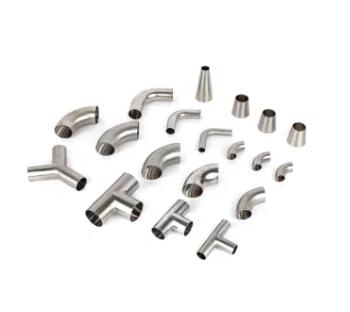What are pipe fittings
2023-10-27
Pipe fittings are components used in plumbing and piping systems to connect, divert, control, or change the direction of pipes and convey various fluids or gases. These fittings play a crucial role in the design and function of plumbing and industrial piping systems. They are designed to create secure and leak-tight connections between different sections of pipes or between pipes and various components, such as valves, pumps, or other equipment.
Pipe fittings come in various shapes, sizes, and types, each serving specific functions within a piping system. Some of the most common types of pipe fittings include:
1. Elbow: Elbows are used to change the direction of a pipeline, typically at 90 or 45-degree angles.
2. Tee: Tees are shaped like the letter "T" and are used to create a branch or intersection in a pipeline, allowing flow in two or more directions.
3. Coupling: Couplings are used to connect two pipes of the same diameter in a straight line. They are often used for extending pipe length.
4. Union: Unions are similar to couplings but can be easily disconnected, allowing for maintenance and repair without disassembling the entire pipeline.
5. Reducer: Reducers are used to connect pipes of different diameters, allowing for a gradual or sudden change in pipe size.
6. Flange: Flanges are flat, disc-like fittings with holes for bolts, used to connect pipes to other components like valves, pumps, and tanks.
7. Nipple: Nipples are short lengths of pipe with male threads on both ends, used to extend a run of pipe.
8. Cap: Caps are used to seal the end of a pipe, preventing the flow of fluids and protecting the interior of the pipe.
9. Plug: Plugs are similar to caps but are often used for closing off an opening in a pipe or component temporarily, allowing for future access.
10. Cross: Cross fittings have four openings, allowing for the intersection of two pipes at right angles.
11. Olet (e.g., Weldolet, Sockolet): Olets are special fittings used to create branch connections from a main pipe or pipe run. Examples include weldolets and sockolets.
12. Bushing: Bushings are used to reduce the size of a pipe fitting opening, allowing for a smaller pipe or component to be connected.
13. Hose Barb: Hose barb fittings have barbed ends for connecting flexible hoses and tubes.
14. Quick-Connect Fitting: Quick-connect fittings allow for easy and tool-free connections, often used in applications like air and fluid lines.
15. Grooved Coupling: Grooved couplings are used in industrial and fire protection systems, featuring grooves and gaskets for easy and secure connections.
The choice of the right pipe fitting depends on the requirements of the specific piping system, including factors like fluid type, pressure, temperature, and the layout of the pipeline. Proper selection and installation of pipe fittings are crucial for the efficient and safe operation of plumbing and piping systems.



